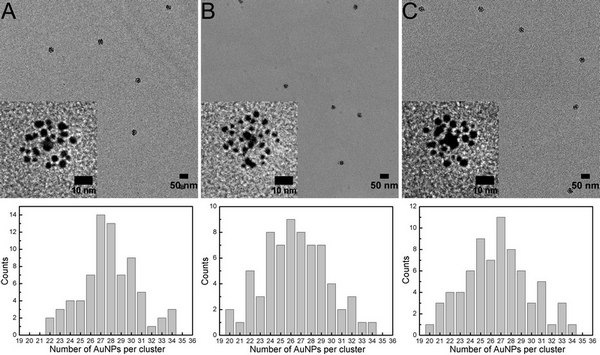Nanomaterials have shown various novel physical and chemical properties in comparison to their bulk materials. Assembling nanoparticles (NPs) into ordered architectures represents a critical step to the fundamental investigation of NP-NP interactions and the fabrication of novel nanodevices. Templated techniques are the most widely used bottom-up strategies for controllable assembly of NPs. Compared with templates generated by chemical or physical methods; biological templates are characterized by high homogeneity in size at the micro- or nanometer scale, ease to manipulate and ready amplification. Therefore, they possess unique advantages in directing the assembly of nanostructures.
Recently, Prof. WANG Qiangbin’s group at Suzhou Institute of Nano-Tech & Nano-bionics, CAS, has developed a facile method for assembling three-dimensional (3D) gold NP (AuNP) clusters with tunable cores using the virus-based NPs (VNPs) of simian virus 40 (SV40) as template (Figure 1), based on their previous works, “Tunable, Discrete, Three-Dimensional Hybrid Nanoarchitectures” (Angew. Chem. Int. Ed., 2011, 50: 4202) and “Monofunctionalization of Protein Nanocages” (J. Am. Chem. Soc., 2011, 133: 20040). They first demonstrated the versatility of SV40 VNPs in encapsulating different NPs, including CdSe@ZnS quantum dots (QDs), Ag2S QDs, and AuNPs. Then they assembled AuNPs onto the outer surface of VNPs in virtue of the interactions (electrostatic force and amine-gold bonding) between the side chains of natural basic amino acids (lysine and arginine) and the AuNPs, resulting in 3D dense clusters of AuNPs (ca. 27 AuNPs per cluster; Figure 2), in which the density of AuNPs can be tuned by adjusting the electrostatic interactions between VNPs and AuNPs. These ordered discrete architectures composed of different NPs provide interesting models which are prohibitively difficult for top-down lithography to fabricate and may find applications in development of novel nanostructures or nanodevices for theranostics of diseases, energy harvesting, biosensing, catalysis, etc. This work provides a facile way in controling NP assembly with protein nanostructures and has been published in Small (10.1002/smll.201201047).
 |
| Figure 1.Scheme of the assembly of 3D AuNP clusters with tunable cores templated by SV40 VNPs. |
 |
| Figure 2.TEM analysis of AuNP-VNP-NP architectures. A-C), AuNP-VNP-CdSe@ZnS, AuNP -VNP-Ag2S, and AuNP-VNP-AuNPs, respectively. Upper panel, TEM images; scale bars, 50 nm; insets, 10 nm. Lower panel, distributions of AuNP number per cluster. |
downloadFile
